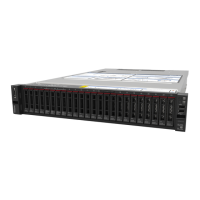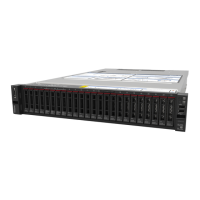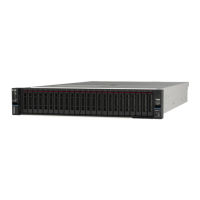KVM switch problems
1. Make sure that the KVM switch is supported by your server.
2. Make sure that the KVM switch is powered on correctly.
3. If the keyboard, mouse or monitor can be operated normally with direct connection to the server, then
replace the KVM switch.
USB-device does not work
1. Make sure that:
• The server is turned on and there is power supplied to the server.
• The correct USB device driver is installed.
• The operating system supports the USB device.
2. Make sure that the USB configuration options are set correctly in system setup.
Restart the server and press the key according to the on-screen instructions to display the LXPM system
setup interface. (For more information, see the “Startup” section in the LXPM documentation compatible
with your server at
https://sysmgt.lenovofiles.com/help/topic/lxpm_frontend/lxpm_product_page.html.)
Then, click System Settings ➙ Devices and I/O Ports ➙ USB Configuration.
3. If you are using a USB hub, disconnect the USB device from the hub and connect it directly to the
server.
4. If the USB device is still not working, try to use a different USB device, or try to connect the USB device
that is being tested to another working USB connector.
5. If the USB device works well on another USB connector, the original USB connector may have a
problem.
• If the USB connector is on the front of the server:
a. Remove and reconnect the USB cable. Ensure that the USB cable is correctly connected to the
system board assembly. See Chapter 6 “Internal cable routing” on page 271
b. Replace the front panel or front I/O module.
• If the USB connector is at the rear of the server:
a. (Trained technician only) Replace the system I/O board.
Memory problems
See this section to resolve issues related to memory.
• “Multiple memory modules in a channel identified as failing” on page 481
• “Displayed system memory is less than installed physical memory” on page 482
• “Invalid memory population detected” on page 483
Multiple memory modules in a channel identified as failing
Note: Each time you install or remove a memory module, you must disconnect the server from the power
source; then, wait 10 seconds before restarting the server.
Complete the following procedure to solve the problem.
1. Reseat the memory modules; then, restart the server.
2. Remove the highest-numbered memory module of those that are identified and replace it with an
identical known good memory module; then, restart the server. Repeat as necessary. If the failures
continue after all identified memory modules are replaced, go to step 4.
3. Return the removed memory modules, one at a time, to their original connectors, restarting the server
after each memory module, until a memory module fails. Replace each failing memory module with an
Chapter 8. Problem determination 481

